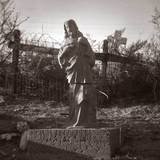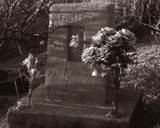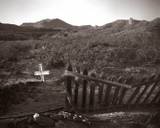home vintage cameras index

Below are some sample photographs from the Duaflex III shot on Efke 25 and developed in Diafine. The pictures were made at an old Camposanto in the desert outside of Rode, New Mexico.



I have a Model II and a Model III Duaflex. Both have hooded finders, focusing Kodar lenses and variable apertures with a range of f8 to f16. My Model III has a two-element lens with an "L" in a circle inscribed on it which indicates an anti-reflective coating. The Model III camera was a little ratty looking when recieved, but it seemed basically solid, and just in need of a good cleanup. Taking it apart required no more than a phillips head screwdriver, but the cheap construction revealed in the process made me wonder if I would get it all back together in working order. I did get the Duaflex reassembled properly in the end, but I did nothing with the camera for some time as it seemed unlikely that I was going to be able to fit a roll of modern 120 film into the narrow space meant for the now-discontinued 620-format film
One day recently, I got to playing with the camera and decided to try a roll of 120 with the spool ends trimmed down to the level of the film's backing paper. It was a very tight fit, but once in place the roll wound through the camera very smoothly. The Duaflex turned out to be an easy, fun shooter. The double exposure prevention feature takes some anxiety out the process, and that big bright screen is a real treat after squinting through so many tiny keyhole-like finders on other old film cameras. The strap lugs make the camera easy to carry in the field, and the neck strap does aid in steadying the camera. I found the shutter release to be a little awkward to manage, and some of my shots with the camera were considerably less sharp than they might have been had I clamped the camera on a tripod.
While the cheaply-made Duaflex probably never won any design awards, it does have a unique claim to fame; it is the camera by far the most likely to have its name misspelled. About half the camera sale listings call this Kodak a Dualflex or a Duraflex. One might conclude that the incidence of dyslixia is higher than imagined, but Kodak has to take some blame for this common error too. After all, "Dua" doesn't really mean anything. My guess is that the Kodak marketing department was trying to make a clever reference to the fact that there are two lenses, but "Duo", "Duad", or "Dual" would have better described that feature. Also, The name is displayed across the top-front of the camera in a cursive style that many of us struggled to learn in grade school, but that probably isn't taught all that rigorously these days.
A user manual for the Duaflex III is available at the Butkus site.
home vintage cameras index
 © mike connealy
© mike connealy